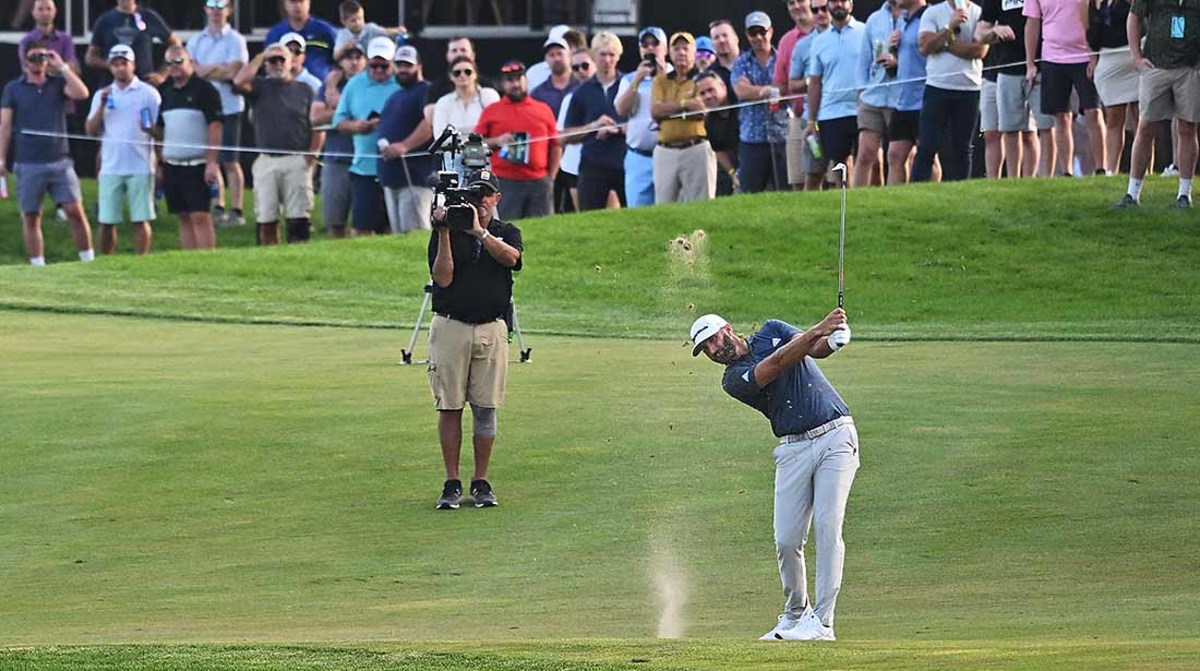In the Broadcasting Battle, the PGA Tour Is Crushing LIV Golf

Since my football team blew a 21-point lead in the fourth quarter and lost at home to a franchise that has made the NFL playoffs three times in the 21st century, switching over to a golf tournament last weekend offered a certain therapeutic appeal, which could be the nicest thing anybody’s ever said about the LIV Golf televisual experience. Sunday afternoons can be quite stressful when your favorite ballclub cannot stop the forward pass. When it comes to a 54-hole event with a shotgun start and meaningless finish, however, there is no such anguish.
There is no reason to care who wins. It is a blessed state of mind.
Still writhing from the 469 yards and six touchdowns we surrendered through the air, my emotional balance had not improved to the point where the NFL’s Sunday night presentation was an option. That meant more golf, this time from the PGA Tour, although the final-round leaderboard in northern California didn’t exactly constitute must-see TV.
The differences in the two telecasts were striking. Golf Channel’s coverage of the Tour’s season-opener was an airtight production deftly handled by three quality announcers, whereas the LIV broadcast still lacks the polish and depth of knowledge you’d expect from a big-league operation. Like a lot of stuff posted on YouTube, it comes off as homemade to the nuanced viewer, which would be fine if we were talking about grandma’s cookies, not a chesty new product with a vastly bloated opinion of itself.

My general manager spent $70 million and a first-round pick on rebuilding his secondary during the offseason. Guess what? He didn’t get his money’s worth, and neither are the Saudis. David Feherty, who delighted audiences for two decades as a curator of kinky humor and purveyor of offbeat insight, seems to have been tranquilized since making the big-bucks leap to the rival league.
A sedate Feherty is somewhat unnerving, particularly in his new role as LIV Golf’s lead analyst. What few people know is that he and Greg Norman are longtime buddies, which might explain why the Shark splurged on such a marquee presence in the booth, but the bright lights have yielded minimal impact. Feherty sounded distracted, almost disconnected, during the final round in Chicago. The live stream was plagued by several lengthy stretches in which nobody said a word—30 seconds of dead air in the TV industry translates to about 18 months of real time—a notable diversion from the over-the-top gabfest two-and-a-half months ago in Portland.
Not that viewers will discover an abundance of insight when somebody does speak. Asked about a 20-foot par save by Cam Smith early on the back nine, Bubba Watson, who was following the lead threesome in an attempt to impersonate an on-course reporter, broke out the 48-ounce can of cliches most tour pros can’t live without.
“He showed a lot of guts, trying to win this tournament,” Bubba replied. You can’t run down to the corner store and buy wisdom like that, folks.
What was Watson doing with a microphone, anyway? Norman gave him the usual outrageous loot to come join the rebel fray, but he still hasn’t played, apparently due to injury. Bubba’s a good guy and all, but he’s not an announcer, which he proved conclusively in Chicago. It’s laughable, the way LIV Golf goes about trying to win friends while ostracizing its enemies, a lot of which has to do with its lack of acknowledgement over the value of the visual medium.
More than 99 percent of all golf fans get their fix by watching it on a screen, not attending tournaments in person. To present such a heavily funded enterprise to the public in such a substandard fashion is strategically criminal—and ironic. Norman shouldn’t want anybody watching his show right now. Not dressed like this.
The Tour, meanwhile, has refrained from responding to the taunts and jabs launched by its cocky adversary, choosing to hide behind a wall of lawyers and wait out the storm. Norman’s declaration that he doesn’t want a truce because his upstart is already successful, Phil Mickelson’s comment that the two organizations need to consolidate because the little guy isn’t going away ... it’s all just hot air and posturing.
Until the fledgling rabble-rouser figures out how to stage its product to the mainstream, Camp Ponte Vedra has nothing to worry about. Deane Beman was keenly aware of how gigantic a priority TV was to the overall health of the sport when he took over as commissioner in 1974—he began buying back the rights to every event immediately after getting the job. Fifty years ago, media ownership was the property of the actual tournaments themselves.
Even an authoritative visionary needed until the end of the 1970s to complete the task, but complete it Beman did. Unlike my team's GM or the billionaire sheiks, he got far more than his money’s worth—those purchases laid the foundation for what has become an undisputed sports empire. With that in mind, it’s hard to imagine a larger gap between two competing entities on a growth element of such importance.
A YouTube deal simply isn’t going to cut it. The relationships with its television partners is perhaps the Tour’s greatest strength, and to that end, it manages the particulars of the programming with both hands. Because it’s a conservative approach with little tolerance for on-air criticism or dicey subject matter, the networks are happy to comply. And while Golf Channel has little choice but to follow along, the Tour knows how crucial that partnership is to the consistency of the brand.
Last Sunday’s offering was a perfect example. Anchor Terry Gannon and booth analyst Curt Byrum were superb on a weird day that included tons of rain and a telecast that opened with the final group on the 16th hole. The decision to go live at the top surely was an easy one—you really don’t have much choice in this day and age—and when Danny Willett threw away his first U.S. victory in more than six years with a three-putt from inside four feet, you had to be at least half nuts to stick around for the full replay.
Byrum doesn’t get any credit, much less the praise, he deserves for the job he does during the early rounds in the heart of the season and as the lead voice at lesser events. He’s so much better than CBS cheerleader Ian Baker Finch that it’s not even close to funny, but then, it’s not supposed to be. Despite his backup status, Byrum shows up at every assignment ready to talk and exceptionally well prepared. He’s not a comedian, but he’s not a pastry chef, either. He tells you what he sees, and in adherence with a strong analyst’s chief asset, he sees a lot.
Gannon seems to have been around forever, and for good reason. He’s another marvelous resource who seems to show up when you might least expect him—wasn’t he just calling an ice-skating competition for a major network last weekend? His versatility resonates to fine effect when hosting a gathering of the little white ball, enhanced by extraordinary conversational skills that get the most out of every guy sitting next to him, even the diffident Nick Faldo.
As was the case when he played for Jim Valvano as the backup point guard on N.C. State’s 1983 national championship squad, Gannon still knows how to run the show. That he and Byrum haven’t been elevated to a greater level of big-event visibility might be of their own choosing, but excellence doesn’t care how many tournaments you cover or how much money you make. That’s another way of saying the Tour’s reserve announcers are head-and-shoulders superior to anybody currently flapping their gums for LIV Golf.
Until Norman finds himself some real starters, that aversion to a truce is surely a ruse.
Reader feedback is welcome at inbox@morningread.com and we may publish your letter (include your name and hometown). Click here to receive all the latest Morning Read news and commentary free in your inbox every morning.
